CHEVROLET TRACKER 1993 Owners Manual
Manufacturer: CHEVROLET, Model Year: 1993, Model line: TRACKER, Model: CHEVROLET TRACKER 1993Pages: 339, PDF Size: 15.75 MB
Page 231 of 339
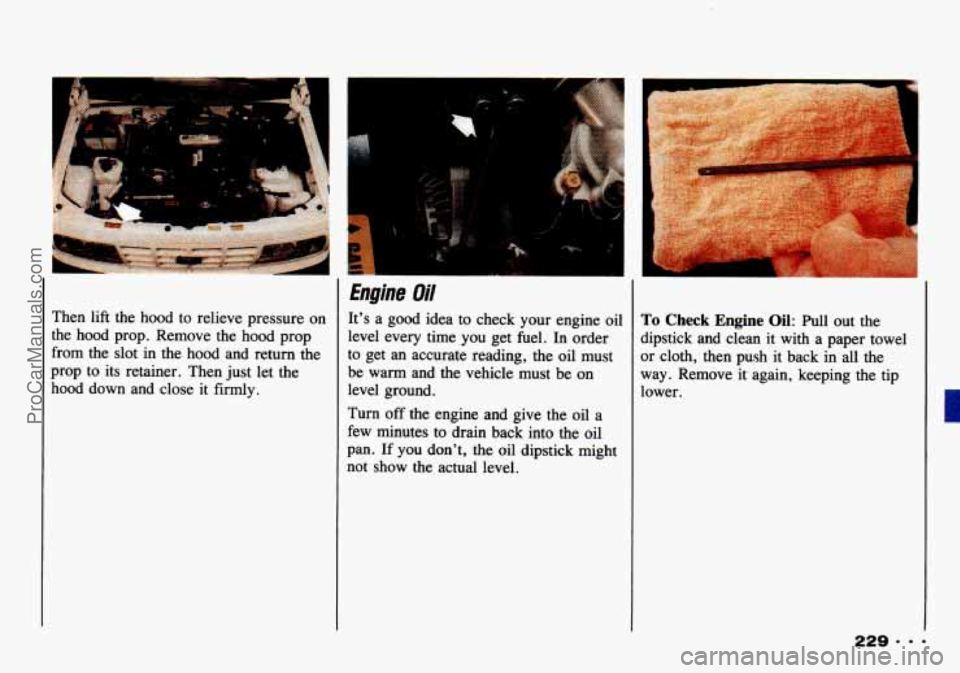
Then lift the hood to relieve pressure on
the hood prop. Remove the hood prop
from the slot in the hood and return the
prop to its retainer. Then just let the
hood down and close it firmly.
Engine Oil
It’s a good idea to check your engine oil
level every time you get fuel.
In order
to get an accurate reading, the oil must
be warm and the vehicle must be on
level ground.
Turn
off the engine and give the oil a
few minutes to drain back into the oil
pan.
If you don’t, the oil dipstick might
not show the actual level.
To Check Engine Oil: Pull out the
dipstick and clean it with a paper towel
or cloth, then push it back
in all the
way. Remove
it again, keeping the tip
lower.
ProCarManuals.com
Page 232 of 339

Service & Appearance Care
I
When to Add Oil: If the oil is at or
below the
ADD mark, you’ll need to
add some oil. But you must use the right
kind. This section explains what kind
of
oil to use. For crankcase capacity, see
“Capacities and Specifications’’ in the
Index. Don’t add
too much oil. If your
engine has
so much oil that the oil
level gets above
the upper mark
that shows the proper operating
range, your engine could be
damaged. Just fill it enough
to put the level
somewhere in the proper operating
range. Push the dipstick all the way
back in when you’re through.
ProCarManuals.com
Page 233 of 339
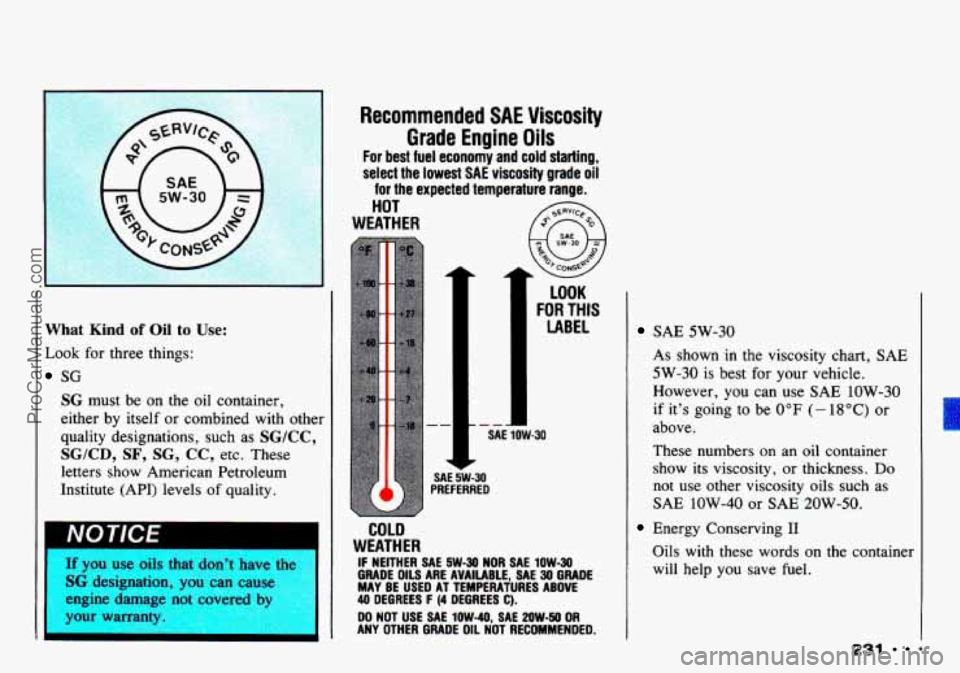
What Kind of Oil to Use:
Look for three things:
SG
SG must be on the oil container,
either by itself or combined with other
quality designations, such
as SGKC,
SG/CD, SF, SG, CC, etc. These
letters show American Petroleum
Institute (API) levels
of quality.
Recommended SAE Viscosity
Grade Engine
Oils
For best fuel economy and cold starting,
select the lowest
SAE viscosity grade oil
for the expected temperature range.
HOT
WEATHER
1-1
@ 1 5W.30
c~coNs.8
LOOK
FOR THIS
LABEL
4$
--
SAE 1OW-30
SAE 5W-30 PREFERRED
COLD
WEATHER
you use oils that don’t have the IF NEITHER SAE 5W-30 NOR SAE 1OW-30
GRADE OILS ARE AVAILABLE, SAE 30 GRADE
MAY BE USED AT TEMPERATURES ABOVE BG designation, you can cause
engine damage not covered
Sy 40 DEGREES F (4 DEOREES C).
your warranty. DO NOT USE SAE 10W-40, SAE 2OW-50 OR 1 ANY OTHER GRADE OIL NOT RECOMMENDED.
SAE 5W-30
As shown in the viscosity chart, SAE
5W-30 is best for your vehicle.
However, you can use SAE
1OW-30
if it’s going to be 0°F (- 18°C) or
above.
These numbers
on an oil container
show its viscosity, or thickness. Do
not use other viscosity oils such as
SAE
1OW-40 or SAE 2OW-50.
Energy Conserving I1
Oils with these words on the container
will help you save fuel.
231
ProCarManuals.com
Page 234 of 339
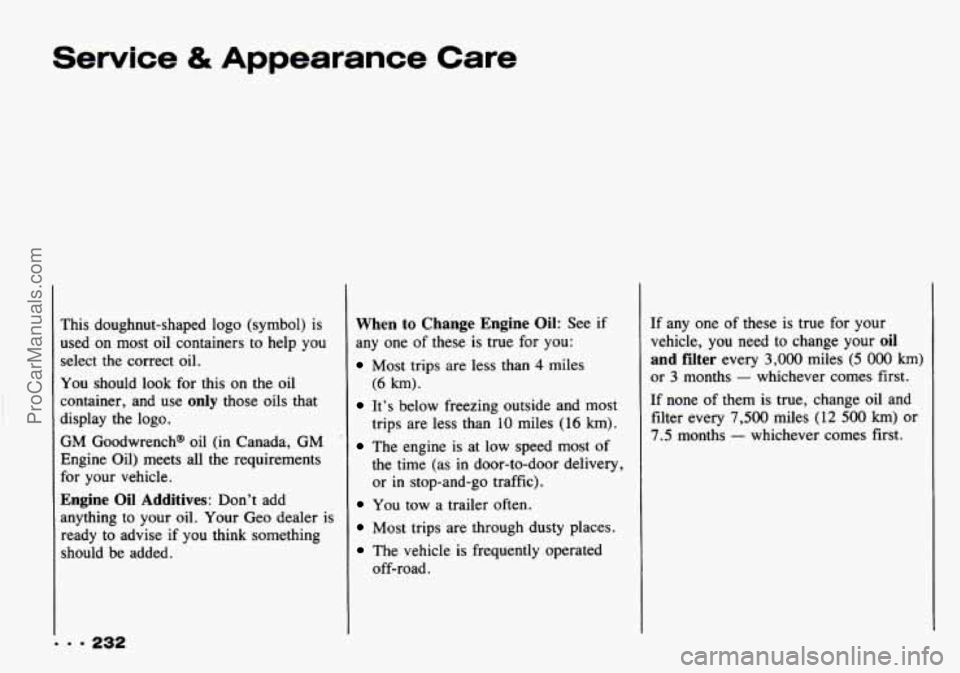
Service & Appearance Care
This doughnut-shaped logo (symbol) is
used on most oil containers to help you
select the correct oil.
You should look for this
on the oil
container, and use
only those oils that
display the logo.
GM Goodwrench@ oil (in Canada, GM
‘
Engine Oil) meets all the requirements
for your vehicle.
Engine Oil Additives: Don’t add
anything to
your oil. Your Geo dealer is
ready to advise if you think something
should be added.
When to Change Engine Oil: See if
any
one of these is true for you:
Most trips are less than 4 miles
(6 km).
It’s below freezing outside and most
trips are less than
10 miles (16 km).
The engine is at low speed most of
the time (as in door-to-door delivery,
or
in stop-and-go traffic).
You tow a trailer often.
Most trips are through dusty places.
The vehicle is frequently operated
off-road.
If any one of these is true for your
vehicle, you
need to change your oil
and filter
every 3,000 miles (5 000 km)
or 3 months - whichever comes first.
If none of them is true, change oil and
filter every
7,500 miles (12 500 km) or
7.5 months - whichever comes first.
ProCarManuals.com
Page 235 of 339

What to Do with Used Oil:
CAUTION
Used engine oil contains
D things that have caused skin
Gancer in laboratory animals.
Don’t let used oil stay on your
skin for very long. Clean your
skin
and nails with soap and water
or a good hand cleaner. Wash or
properly throw away clothing or
rags containing
used engine oil. Used
oil can be
a real threat to the
environment. If you change your own
oil, be sure to drain all free-flowing oil
from the filter before disposal. Don’t
ever dispose of it by pouring it on
the
ground, into sewers, or into streams or
bodies of water. Instead, recycle it by
taking
it to a place that collects used oil.
If you have a problem properly
disposing of your used oil, ask your
dealer, a service station or a local
recycling center for help.
-m
Air Cleaner
Refer to your Maintenance Schedule to
determine when to replace the air filter.
See “Scheduled Maintenance Services”
in the Index.
A Operating the engine with the
L air cleaner off can cause you
or others to be burned. The air
cleaner not only cleans the air, it
stops flame if the engine backfires.
If it isn’t there, and the engine
backfires, you could be burned.
Don’t drive with
it off, and be
careful working,on the engine with
the air cleaner off.
233 - =
ProCarManuals.com
Page 236 of 339
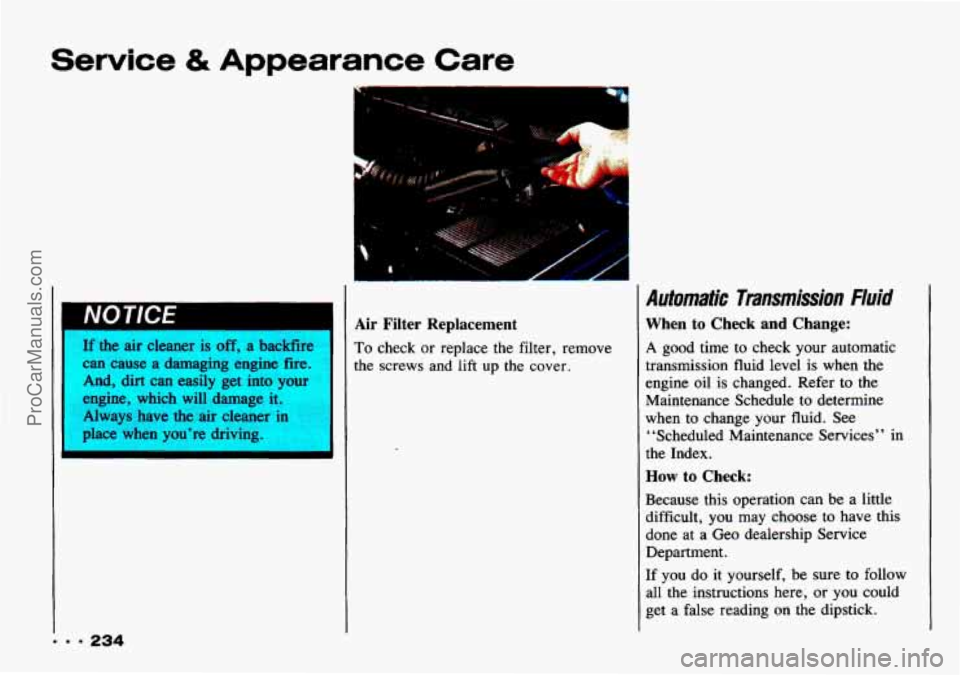
Service & Appearance Care
c
If the air cleaner is off, a backfire
can cause a damaging engine fire.
And, dirt can easily get into your
engine, which will damage it.
Always have
the air cleaner in
place when you're driving.
... 234
Air Filter Replacement
To check or replace the filter, remove
the screws and lift up the cover.
Automatic Tmnsmissian Fluid
When to Check and Change:
A good time to check your automatic
transmission
fluid level is when the
engine oil is changed. Refer to the
Maintenance Schedule to determine
when to change your fluid. See
"Scheduled Maintenance Services"
in
the Index.
How to Check:
Because this operation can be a little
difficult, you may choose to have this
done at a Geo dealership Service
Department.
If you do
it yourself, be sure to follow
all the instructions here, or you could
get a false reading
on the dipstick.
ProCarManuals.com
Page 237 of 339
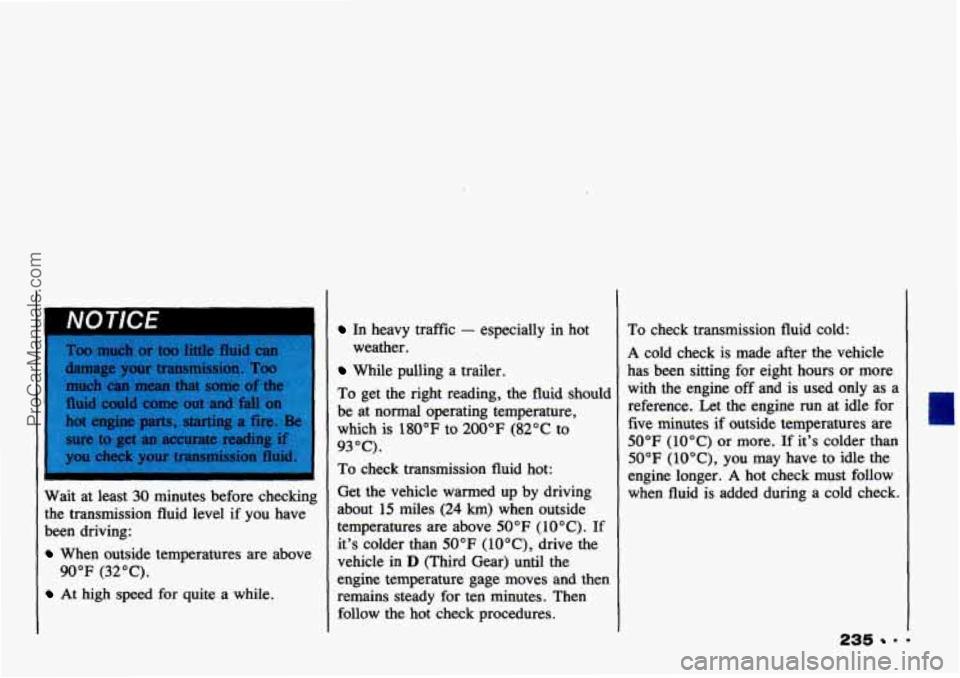
' /vu I IL-t
Wait at least 30 minutes before checking
the transmission fluid level if you have
been driving:
When outside temperatures are above
At high speed for quite a while.
90°F (32°C).
In heavy traffic - especially in hot
While pulling a trailer.
To get
the right reading, the fluid should
be at normal operating temperature,
which is
180°F to 200°F (82°C to
93°C).
To check transmission fluid hot:
Get the vehicle warmed up by driving
about
15 miles (24 km) when outside
temperatures are above
50°F (10°C). If
it's colder than 50°F (lO°C), drive the
vehicle in
D (Third Gear) until the
engine temperature gage moves and then
remains steady for ten minutes. Then
follow the hot check procedures.
weather.
To
check transmission fluid cold:
A cold check is made after the vehicle
has been sitting for eight hours or more
with the engine
off and is used only as a
reference. Let the engine run at idle for
five minutes if outside temperatures are
50°F (10°C) or more. If it's colder than
50°F (lO°C), you may have to idle the
engine longer.
A hot check must follow
when fluid
is added during a cold check.
U
235 9
ProCarManuals.com
Page 238 of 339

Service & Appearance Care
... 236
Let the engine run at idle for three
minutes or more.
To check the fluid hot or cold:
Park your vehicle on a level place.
Place the shift lever in P (Park) with
the parking brake applied.
With your foot on the brake pedal,
move the shift lever through each gear
range, pausing for about three seconds
in each range. Then, position the shift
lever in
P (Park).
Then, without shutting off the engine,
follow these steps:
1. Pull out the dipstick and wipe it with
2. Push it back in all the way, wait
a clean rag
or paper towel.
three seconds and then pull
it back
out again.
3. Check both sides of the dipstick, and
read the lower level. The fluid level
must be
in the COLD (A) area for a
cold check or in the
HOT (B) or
cross-hatched area for a hot check.
4. If the fluid level is where it should
be, push the dipstick back
in all the
way.
How to Add Fluid:
Refer to the Maintenance Schedule to
determine what kind of transmission fluid to use.
See “Recommended Fluids
and Lubricants”
in the Index.
If the fluid level is low, add only
enough of the proper fluid to bring the
level up into the COLD area for a cold
check or the
HOT area for a hot check.
It doesn’t take much fluid, generally less
than a pint. Don’t overfill. We
recommend you use only fluid labeled
DEXRON@-11, because fluids with that
label are made especially for our
automatic transmission. Damage caused
by fluid other than DEXRON@-I1 is not
covered by your new vehicle warranty.
ProCarManuals.com
Page 239 of 339
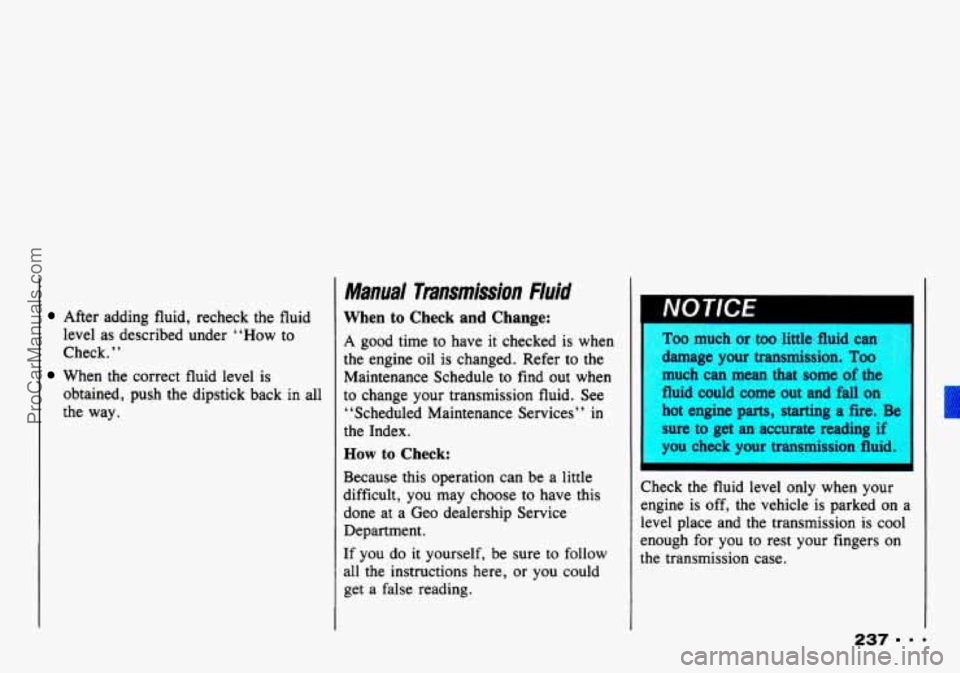
After adding fluid, recheck the fluid
level as described under “How to
Check.
”
obtained, push the dipstick back in all
the way.
When the correct fluid level is
Manual Transmiisioon Fluid
When to Check and Change:
A good time to have it checked is when
the engine oil is changed. Refer to the
Maintenance Schedule to find out
when
to change your transmission fluid. See
‘ ‘Scheduled Maintenance Services’ ’ in
the Index.
How to Check:
Because this operation can be a little
difficult, you may choose to have this
done at a Geo dealership Service
Department.
If you do
it yourself, be sure to follow
all the instructions here, or you could
get
a false reading.
90 much or too little fluid can
...anage your transmission.
Too
much can mean that some of the
fluid could come
out and fall on I
hot engine parts, starting a fire.
I sure to get an accurate reading if
you check your transmission fluid.
I
Check the fluid level only when your
engine is off, the vehicle is parked on a
level place and the transmission
is cool
enough
for you to rest your fingers on
the transmission case.
237 8
ProCarManuals.com
Page 240 of 339
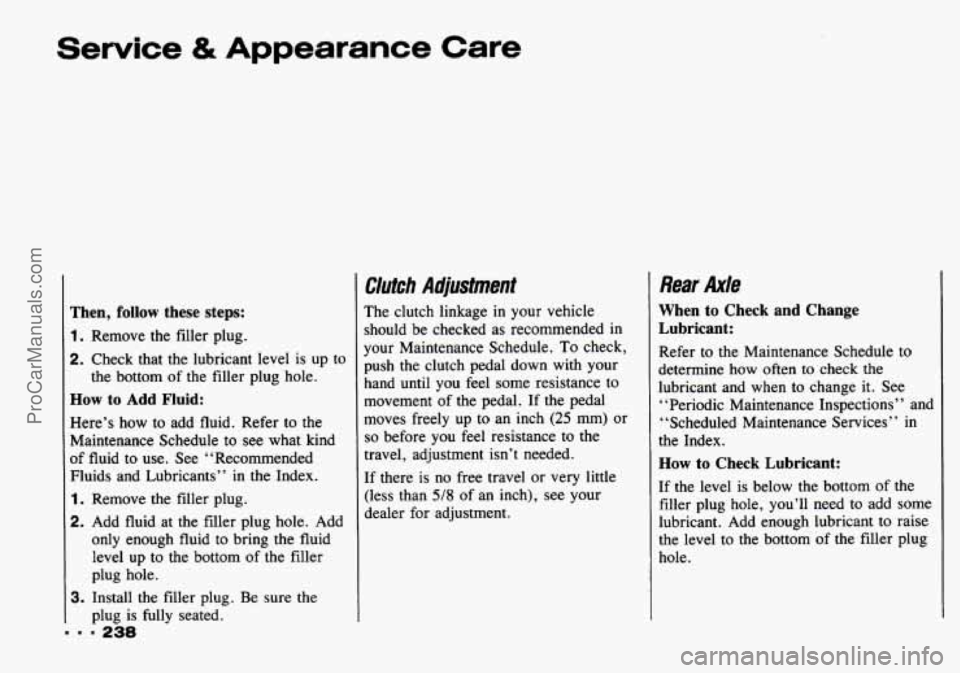
Then, follow these steps:
1. Remove the filler plug.
2, Check that the lubricant level is up to
the bottom of the filler plug hole.
How to Add Fluid:
Here’s how to add fluid. Refer to the
Maintenance Schedule to see what kind
of fluid to use. See “Recommended
Fluids and Lubricants” in the Index.
1 . Remove the filler plug.
2. Add fluid at the filler plug hole. Add
only enough fluid to bring the fluid
level
up to the bottom of the filler
plug hole.
plug is fully seated.
3. Install the filler plug. Be sure the
Clutch Adjustment
The clutch linkage in your vehicle
should be checked as recommended in
your Maintenance Schedule. To check,
push the clutch pedal down with your
hand until you feel some resistance to
movement of the pedal. If the pedal
moves freely up to an inch
(25 mm) or
so before you feel resistance to the
travel, adjustment isn’t needed.
If there is no free travel or very little
(less than
5/8 of an inch), see your
dealer for adjustment.
Rear Axle
When to Check and Change
Lubricant:
Refer to the Maintenance Schedule to
determine how often
to check the
lubricant and when to change it. See
“Periodic Maintenance Inspections” and
“Scheduled Maintenance Services” in
the Index.
How to Check Lubricant:
If the level is below the bottom of the
filler plug hole, you’ll need to add some
lubricant. Add enough lubricant to raise
the level to the bottom of the filler plug
hole.
ProCarManuals.com